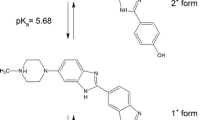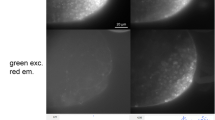Summary
If the DNA nucleoside thymidine is replaced by bromodeoxyuridine, the fluorescence of the nuclei of Hoechst-stained cells is quenched. The decrease of fluorescence intensity determined by flow cytometry and fluorometry is neutralized independent of the degree of BrdU substitution by an UV-exposure with a dose of 5–10 kJ/m2 to the unfiltered spectrum of a 100 W mercury high-pressure lamp. This dose is equivalent to that obtained in fluorescence microscopy after exposure for about 1 s. We suppose that this approximate matching of the intensities both of normal and BrdU-substituted cells is caused by the splitting-off of bromine from BrdU in the DNA resulting in no further quenching. However, the fluorescence intensity of normal Hoechst-stained DNA also is increased by a previous exposure to UV light. We explain the time pattern of the Hoechst fluorescence in the course of an exposure with constant dose rate, by the superimposition of the well-known bleaching by an additional increase of the fluorescence intensity. Our results suggest that the UV-exposure of Hoechst dye creates a brightly fluorescing photoproduct which differs spectroscopically from the original dye. This product is stable in the dark and seems to fluorochrome DNA only if it is formed when the Hoechst dye is bound to DNA, thus increasing the nuclear fluorescence. Phosphorescence was not found.
Similar content being viewed by others
Abbreviations
- BrU-cells:
-
5-bromodeoxyuridine holding S-180 cells
- T-cells:
-
S-180 cells with normal (thymine) DNA
- ICP:
-
pulse cytophotometer
References
Böhmer R-M (1978) Entwicklung neuer flußzytometrischer Meßverfahren und ihr Einsatz zur Untersuchung der Proliferationskinetik bei Säugetierzellen in Kultur. Thesis, Fachbereich Physik, Universität Hamburg
Craig-Holmes AP, Shaw MW (1976) Cell cycle analysis in asynchronous cultures using the BUdR-Hoechst technique. Exp Cell Res 99:79–87
Davies RJH (1980) The ultraviolet photochemistry of nucleic acids and their components. Photochem Photobiol 31:623–626
Dittrich W, Göhde W (1970) Phase progression in two dose response of Ehrlich ascites tumour cells. ATKE 15:174–176
Goto K, Maeda S, Kano Y, Sugiyama T (1978) Factors involved in differential Giemsa-staining of sister chromatids. Chromosoma 66:351–359
Hilwig I (1978) The fluorochrome “33258 Hoechst”. In: Haanen CAM, Hillen HFP, Wessels JMC (eds) First international symposium on Pulse-Cytophotometry. Part III. European Press Medikon, Ghent, pp 239–250
Hutchinson F, Köhnlein W (1980) The photochemistry of 5-bromouracil and 5-jodouracil in DNA. A review. Prog Mol Subcell Biol 7:1–42
Latt SA (1977) Fluorometric detection of deoxyribonucleic acid synthesis. Possibilities for interfacing bromodeoxyuridine dye techniques with flow fluorometry. J Histochem Cytochem 25:913–926
Latt SA, George YS, Gray JW (1977) Flow cytometric analysis of bromodeoxyuridine-substituted cells stained with 33258 Hoechst. J Histochem Cytochem 25:927–934
Latt SA, Stetten G (1976) Spectral studies on 33258 Hoechst and related bisbenzimidazole dyes useful for fluorescent detection of deoxyribonucleic acid synthesis. J Histochem Cytochem 24:23–33
Latt SA, Wohlleb JC (1975) Optical studies of the interaction of 33258 Hoechst with DNA, chromatin, and metaphase chromosomes. Chromosoma 52:297–316
List PH, Hörhammer L (Eds) (1969) Hagers Handbuch der Pharmazeutischen Praxis, Vol II. Springer, Berlin Heidelberg New York, p 1023
Marmur J (1961) A procedure for the isolation of deoxyribonucleic acid from micro-organisms. J Mol Biol 3:208–218
Mönkehaus F, Köhnlein W (1973) Single- and double-strand breaks in 5-bromouracil-substituted DNA of B. subtilis and phage PBSH after irradiation with long-wave length UV and their correlation to intramolecular energy transfer. Biopolymers 12:329–340
Noguchi PD, Johnson JB, Browne W (1981) Measurement of DNA synthesis by flow cytometry. Cytometry 1:390–393
Sinclair RS (1980) The light stability and photodegradation of dyes. Photochem Photobiol 31:627–629
Stetten G, Latt SA, Davidson RL (1976) 33258 Hoechst enhancement of the photosensitivity of bromodeoxyuridine-substituted cells. Somat Cell Genet 2:285–290
Zimmermann SB, Pfeiffer BH (1979) A direct demonstration that the ethanol-induced transition of DNA is between the A and B forms: an X-ray diffraction study. J Mol Biol 135:1023–1027
Author information
Authors and Affiliations
Rights and permissions
About this article
Cite this article
Severin, E., Ohnemus, B. UV dose-dependent increase in the hoechst fluorescence intensity of both normal and BrdU-DNA. Histochemistry 74, 279–291 (1982). https://doi.org/10.1007/BF00495837
Received:
Accepted:
Issue Date:
DOI: https://doi.org/10.1007/BF00495837




